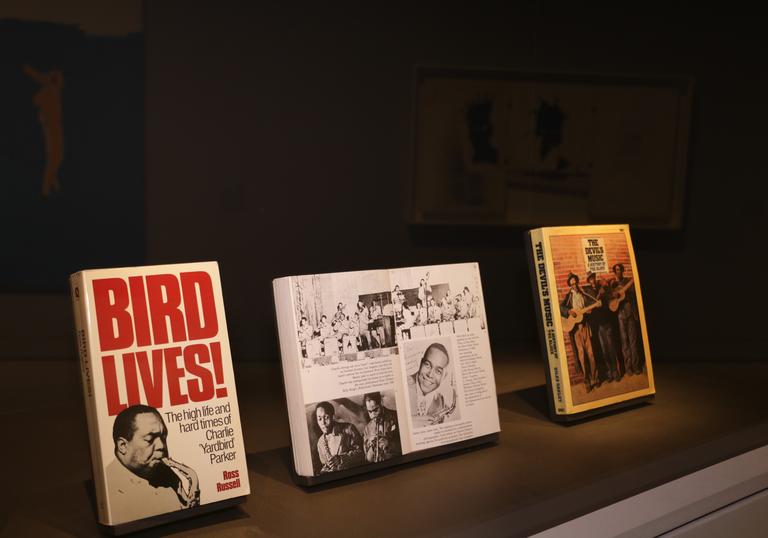I get my facts from books, stuff on atomizers, the blues, ethyl alcohol, geese in Egyptian glyphs […] I don’t take credit for my facts. The facts exist without me
Jean-Michel Basquiat took inspiration from a dizzying array of source material. In many ways his style of working – with books spread open on the studio floor, records playing and the television always on – anticipated the bombardment of information in our digital culture today.
See which literary references you can spot in the photo gallery of his paintings…
Jean-Michel Basquiat, Untitled (Alice in Wonderland), 1983
As the title suggests, familiar characters from Lewis Carroll’s Alice in Wonderland punctuate this work, including the Mad Hatter (complete with teacups and sugar as if in the middle of his famous tea party), the Cheshire Cat, the Caterpillar and Tweedle Dee and Tweedle Dum. Their cartoon style suggests that they originate from the Disney film adaptation from 1951, the title song of which became a jazz standard.
The collage is held together with masking tape to create a complex design, intended to be photo-mechanically enlarged into a silkscreen. Basquiat used this work as the basis for 'Wine of Babylon' (1984), in which he gave the Mad Hatter a black face, a transformation that challenged the overwhelming dominance of white characters within popular culture and in Disney productions in particular.
Jean-Michel Basquiat, Moses and the Egyptians, 1982
The title of this work relates to the Old Testament, in which Moses frees the Israelites from slavery in Egypt. The work is dominated by a striking pink paint, representing the two stone tablets ‘inscribed by the finger of God’, which were given to Moses on Mount Sinai. The name ‘MOSES’ is written five times to the left, referencing the Ten Commandments written on the tablets. To the right, the name ‘MOSES’ stands alone, as if to underline the singular importance of ‘His chosen one’. In the middle is the profile of a head with an Egyptian-style eye, which seems likely to have come from Jean Carlu’s cover design for the 1967 edition of Sigmund Freud’s Moses and Monotheism (1939). In this text, Freud argues that the primal desire of individuals is to trace their bloodline back to royalty.
Exhibition Reading List
- Giles Oakley, The Devil’s Music, 1976
- Ross Russell, Bird Lives! The High Life and Hard Times of Charlie ‘Yardbird’ Parker, 1973 (Basquiat’s original copy shown in show)
- Frank Driggs and Harris Lewine, Black Beauty White Heat: A Pictorial History of Classic Jazz, 1920–1950, 1982 (Basquiat’s original copy shown in show)
- Leonardo da Vinci, 1452–1519, 1966 (Basquiat’s original copy shown in show)
- Burchard Brentjes, African Rock Art, 1969
- W. Janson, A History of Art, 1962
- Jean Dubuffet: A Retrospective Glance at Eighty, 1981
- Henry Dreyfuss, Symbol Sourcebook, 1984
- Robert Farris Thompson, Flash of the Spirit: African and Afro-American Art and Philosophy, 1983
- Henry Gray, Gray’s Anatomy, 1858
- Ripley’s Believe It or Not!, Great Disasters, 1979
- Jack Kerouac, The Subterraneans, 1958
- Sigmund Freud, Moses and Monotheism, 1967
Basquiat: Boom For Real took place from 21 September–28 January 2018

